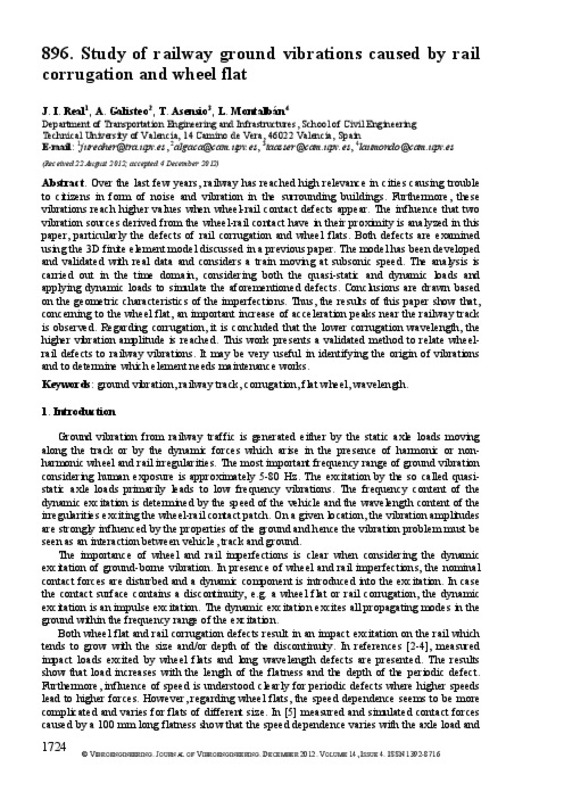JavaScript is disabled for your browser. Some features of this site may not work without it.
Buscar en RiuNet
Listar
Mi cuenta
Estadísticas
Ayuda RiuNet
Admin. UPV
Study of railway ground vibrations caused by rail corrugation and wheel flat
Mostrar el registro sencillo del ítem
Ficheros en el ítem
| dc.contributor.author | Real Herráiz, Julia Irene
|
es_ES |
| dc.contributor.author | Galisteo Cabeza, Alberto
|
es_ES |
| dc.contributor.author | Asensio Serrano, Tamara
|
es_ES |
| dc.contributor.author | Montalbán Domingo, María Laura
|
es_ES |
| dc.date.accessioned | 2015-11-03T12:36:24Z | |
| dc.date.available | 2015-11-03T12:36:24Z | |
| dc.date.issued | 2012-12 | |
| dc.identifier.issn | 1392-8716 | |
| dc.identifier.uri | http://hdl.handle.net/10251/56931 | |
| dc.description.abstract | Over the last few years, railway has reached high relevance in cities causing trouble to citizens in form of noise and vibration in the surrounding buildings. Furthermore, these vibrations reach higher values when wheel-rail contact defects appear. The influence that two vibration sources derived from the wheel-rail contact have in their proximity is analyzed in this paper, particularly the defects of rail corrugation and wheel flats. Both defects are examined using the 3D finite element model discussed in a previous paper. The model has been developed and validated with real data and considers a train moving at subsonic speed. The analysis is carried out in the time domain, considering both the quasi-static and dynamic loads and applying dynamic loads to simulate the aforementioned defects. Conclusions are drawn based on the geometric characteristics of the imperfections. Thus, the results of this paper show that, concerning to the wheel flat, an important increase of acceleration peaks near the railway track is observed. Regarding corrugation, it is concluded that the lower corrugation wavelength, the higher vibration amplitude is reached. This work presents a validated method to relate wheelrail defects to railway vibrations. It may be very useful in identifying the origin of vibrations and to determine which element needs maintenance works. | es_ES |
| dc.language | Inglés | es_ES |
| dc.publisher | Research Center of the Public Institution "Vibromechanika" | es_ES |
| dc.relation.ispartof | Journal of Vibroengineering | es_ES |
| dc.rights | Reserva de todos los derechos | es_ES |
| dc.subject | Ground vibration | es_ES |
| dc.subject | Railway track | es_ES |
| dc.subject | Corrugation | es_ES |
| dc.subject | Flat wheel | es_ES |
| dc.subject | Wavelength | es_ES |
| dc.subject.classification | INGENIERIA E INFRAESTRUCTURA DE LOS TRANSPORTES | es_ES |
| dc.title | Study of railway ground vibrations caused by rail corrugation and wheel flat | es_ES |
| dc.type | Artículo | es_ES |
| dc.rights.accessRights | Abierto | es_ES |
| dc.contributor.affiliation | Universitat Politècnica de València. Departamento de Ingeniería e Infraestructura de los Transportes - Departament d'Enginyeria i Infraestructura dels Transports | es_ES |
| dc.contributor.affiliation | Universitat Politècnica de València. Instituto Universitario de Matemática Multidisciplinar - Institut Universitari de Matemàtica Multidisciplinària | es_ES |
| dc.description.bibliographicCitation | Real Herráiz, JI.; Galisteo Cabeza, A.; Asensio Serrano, T.; Montalban Domingo, ML. (2012). Study of railway ground vibrations caused by rail corrugation and wheel flat. Journal of Vibroengineering. 14(4):1724-1733. http://hdl.handle.net/10251/56931 | es_ES |
| dc.description.accrualMethod | S | es_ES |
| dc.relation.publisherversion | http://jvejournals.com/browse-jve | es_ES |
| dc.description.upvformatpinicio | 1724 | es_ES |
| dc.description.upvformatpfin | 1733 | es_ES |
| dc.type.version | info:eu-repo/semantics/publishedVersion | es_ES |
| dc.description.volume | 14 | es_ES |
| dc.description.issue | 4 | es_ES |
| dc.relation.senia | 241347 | es_ES |






